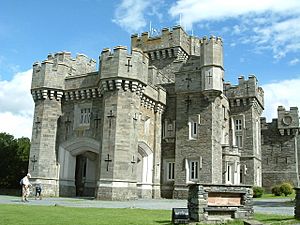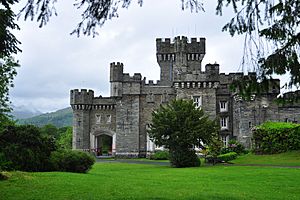Wray Castle facts for kids

Wray Castle: its gothic features include fake arrowslits
|
|
| Established | 2011 |
|---|---|
| Location | Claife, South Lakeland, Cumbria |
| Owner | National Trust |
| Public transit access | See website |
|
Listed Building – Grade II
|
|
| Official name | R.M.S. Wray Castle |
| Designated | 25 March 1970 |
| Reference no. | 1106324 |
|
Listed Building – Grade II
|
|
| Listings | 5 including Retaining Walls and Boathouse |
Wray Castle is a beautiful old building in Claife, Cumbria, England. It looks like a castle from a fairy tale, built in a style called neo-gothic. It has been owned by the National Trust since 1929. For many years, you could only visit the outside grounds. But now, the castle itself is open to everyone regularly!
The castle grounds are open all year. They are famous for their amazing trees. You can see giant Wellingtonia trees, tall redwoods, and unique Ginkgo biloba trees. There are also pretty weeping lime and different kinds of beech trees.
If you want to visit, you can even take a boat! Between March and October, Windermere Lake Cruises offer boat trips to Wray Castle. You can catch a boat from Ambleside or the Brockhole National Park Visitor Centre.
Contents
The Story of Wray Castle
How Wray Castle Began
Wray Castle was built in 1840. A retired surgeon from Liverpool, James Dawson, had it built. He used his wife's money to create this grand home and the nearby Wray Church.
After James Dawson passed away in 1875, his 15-year-old nephew, Edward Preston Rawnsley, inherited the estate. A few years later, in 1877, Edward's cousin, Hardwicke Rawnsley, became the vicar of Wray Church.
The National Trust Idea
Hardwicke Rawnsley was very important for protecting nature. He wanted to save the beautiful countryside from being built on. He had an idea, inspired by John Ruskin, to create a special group. This group, which became the National Trust, would buy and protect beautiful places and historic buildings for everyone to enjoy.

Beatrix Potter's Connection
Wray Castle has a special link to another important person for the National Trust: Beatrix Potter. She was a famous author and illustrator, known for books like The Tale of Peter Rabbit. When she was 16, in 1882, Beatrix spent a summer holiday at Wray Castle with her family. This visit made her fall in love with the Lake District.
Later, in 1905, Beatrix bought a small farm called Hill Top nearby. She used the money she earned from her first book to buy it. Over time, she bought a lot more land in the area. Even though she never owned Wray Castle itself, her love for the region helped protect it.
Wray Castle Joins the National Trust
In 1929, Wray Castle and about 64 acres of land were given to the National Trust. This generous gift came from Sir Noton and Lady Barclay.
What Wray Castle Was Used For
After the National Trust took over, Wray Castle was used for different things:
- For a short time in 1929, it was a youth hostel, a place where young travelers could stay cheaply.
- From 1931 for 20 years, it was home to the offices of the Freshwater Biological Association. This group studies life in lakes and rivers.
- From 1958 to 1998, Wray Castle became a training college for people who worked as radio officers on Merchant Navy ships. These officers learned how to use radios to keep ships safe at sea. Up to 150 students lived in the castle while they studied.
Wray Castle Today
By 2004, the training college had moved out of the castle. In 2011, the National Trust thought about renting out the castle to be a hotel. But then, they decided to open it to the public for a visitor season.
Many people came to visit! Because the castle was mostly empty, it was a great place for kids to explore and play. This showed the National Trust that Wray Castle could be a wonderful place for families to visit. So, in 2014, they officially made it a visitor attraction.
A Ship Named Wray Castle
Did you know a ship was named after Wray Castle? It was a large iron ship with four masts. It was built in March 1889 at a shipyard in Workington. The Wray Castle was one of five big ships built for the Lancaster Shipowners Company.


